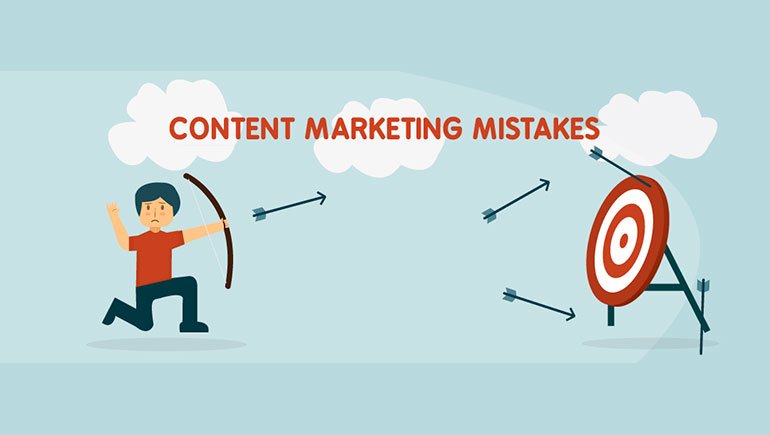Content writing: What is it?
The process of planning, researching, creating, editing, and releasing information for the internet is known as content writing. This content writing
comprises a variety of formats, including press releases, e-books, blog pages, online content writing, ad copy, and social media templates.
Simply said, content conveys your brand's story and reflects it. Case studies, insights, and scenarios can be used to convey a message and motivate
readers to take significant action.
Content has become a crucial component of every marketing plan used to expand a business in the current digital era. Don't risk the readers' ignorance
of the content writing errors by taking any chances.
10 Content creation Mistakes to Avoid
Understanding Your Viewers
Content creation is not recognized until the needs of audiences or readers are understood. You must select a topic that is both informative and
interesting to your target audience. If you want your reader's full attention and to avoid bounces, you must understand what they are anticipating.
Articles are read for three reasons.
- To learn about current trends, technological advances, or brands.
- Locate a problem's solution
- Because they believe the topic is too important to them
Before creating the post, create an audience profile and address the challenges by offering full information. You might begin by learning about the
primary interests of your intended consumers. Know what difficulties they are looking for and choose a theme that revolves round them.
This will assist you in determining the most relevant topic between what your users want to read and what you want to tell them. It serves as a
basis for determining the sort of content and method of presenting facts to them.
Poor Investigation
Even if you are familiar with the issue, you should conduct research. It clears up any questions and teaches you about fresh updates and statistics
that might help you with your writing. Users believe data and proof above opinions. Every sentence you publish should be valuable to your viewers.
Although this might be a tedious chore, it is a vital element of content production and must be made entertaining. Spend time researching the issue
and learning new things. This method may sometimes lead to fresh solutions to old issues, new knowledge, difficulties, and downsides that your
readers will find interesting.
For instance, suppose your theme is modern technology. Outlining and optimizing the post will be aided by some study on past technologies and
upgrades in the new one. Successful investigation gives comprehensive material that may be used to write about comparable topics in the years to
come.
No Content Planning
No Content Planning: This is one of the many frequent errors bloggers make while writing and results in a difficult time creating articles. Many skilled
writers encourage beginning authors to plan out what will come first, second, and third in their essay.
The above-mentioned research procedure will assist you in preparing your content creation. You may write down headers, points to include, supporting
backlinks, keywords, and other information. It assists you in covering all key sections of your material in order to provide an overview of creating an
article.
You might separate the structure of the content to focus more on writing, like:
- Begin your piece by informing readers that you have recognized their problem. How they will profit from reading your content and how you will
capture their attention.
- Make a section for each topic you wish to convey and provide evidence to back it up. Make an effort to be precise and explicit.
- Include useful stuff with examples and use headers and subheadings in the article.
- End your essay by summarizing the points or directing readers to the aforementioned solution. You may also request comments.
Not Having Specific Objective
Do you know what you want to accomplish with this piece of content? It might be about amusing your readers, providing information, or convincing them to
act.
Define your aim and have a clear picture of the end result. It may assist you with writing style, tone, structuring material, including statistics, and
focusing on content to interest your target audience. As a result, your viewers will not find your information dull, confused, or missing in purpose.
Explaining the most recent innovations to ordinary readers and scientists, for example, are not one and the same thing. In the earlier piece of writing,
you must use broad instances to explain, however in the later, you can provide a more detailed explanation.
Never Neglect Keyword Research
Keywords serve as elements of structure and assist you in remaining focused on your writing. You'll know what to write once you've determined which
keywords to include. These keywords are crucial if you want to rank high in search engines. Conduct thorough study to identify fresh long tails, seed
keywords, and lengthy sentences to include in your articles.
Remember to include search terms in your content that people will use to locate solutions. These terms assist you in appearing on the top pages of
search results. However, remember that content quality and relevancy are more essential than keyword density. Take cautious not to include irrelevant
terms in your lines. Keyword analysis resources such as SEMrush, Google Keyword Planner, Ahrefs, and others can help you.
Keep an eye on content size
All writers must remember that quality always triumphs over material length.
Long articles are beneficial when they include valuable and helpful material. Understand the context and avoid adding needless subheadings to lengthen
the content. There will be no reader effort in reading needless stuff. This can potentially harm your reputation and cause a decline in readership.
Tips for optimizing content length:
- Do your homework and organize your article's parts;
- Do your homework and organize your article's parts;
- Complement the text with relevant examples that offer value.
- Avoid extending the topic for the sake of keywords.
- When creating comprehensive research content, stay focused on the topic.
Letting Search Engine Optimization Out
If your material is for search engine sites, you can't ignore SEO.
There are several SEO ranking criteria that contribute to your content appearing on the top pages of search results. However, there are a few things you
can do when writing to optimize the content for search engines.
- Incorporate user search intent keywords into the material.
- Include keywords in heading, subheadings, introductory paragraphs, alt pictures, and so on.
- Provide relevant internal and external links.
Don't Forcibly Insert CTA Buttons
Call to Action buttons are designed to compel readers to take urgent action. It may be going to the website, signing up for a newsletter, or seeking
additional content.
It is not suggested to add these CTA buttons in the content just to get the readers' attention. This may irritate your readers, prompting them to seek
alternative resources. In the worst-case scenario, people may visit other blogs on your website as a result of their experience.
Let's Face It: Every content writer has writer's block at some time
However, try to find some inspiration and get started. You can go through your prior study to identify a point or look for fresh resources. Take a break
and do something entertaining to refuel your brain and generate new writing ideas. Also, attempt to maintain consistency to assist you overcome writer's
block and improve your work.
Supervision Content Formatting
Each article must be arranged with appropriate headers and subheadings. Readers may become confused and quit the content, increasing your bounce rate.
It's extremely normal for users to skim the blog's material before diving in. This is to determine whether the article is valuable and contains the
relevant information. As a result, it is critical to have a proper article structure with significant parts.
An article's basic structure is
Heading 1
- Subheading 1
- Subheading 2
Heading 2
- Subheading 1
- Subheading 2
Heading 3
- Subheading 1
Subheading 1
- Subheading 2
While publishing in the digital media, distinguish your material for better understanding.
- Use H1, H2, H3 to indicate headers;
- Bold, italicize, and underline words to emphasize;
- Utilize bullet and numbered points over paragraph for unambiguous presentation;
- Color links to make them stand out in the material.
Final Remarks
We create articles to assist readers and to deliver relevant and authentic information. Keeping this in mind, you must avoid making any article writing
blunders that may turn off your visitors. This essay will assist you in identifying such errors, keeping an eye on them, and not repeating them in your
work. Of course, you can always employ content writing tools to help you create the greatest material.
Joining content writing clubs or communities on social media sites might be beneficial. It allows you to discuss various thoughts and discover new
things to help you better your writing.
Constantly write your essay from the perspective of the reader, and experiment with fresh approaches to express your views.



